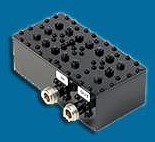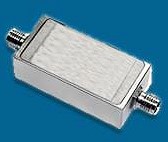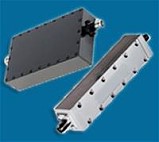|

Anatech Electronics, an RF and microwave filter company, has introduced a new
line of suspended stripline and waveguide type RF filters. Also, Sam Benzacar wrote
as part of his April newsletter an article entitled "5G Brings EM Radiation Front
and Center," which discusses the physiological implications of cellphone and
WiFi radiation on humans. As with so many things, politics and money (intimately
entwined) drive the issue with little concern for the truth. On a lighter note,
the topics of FCC spectrum auctions, Google Fiber disappearance in some
locations, and rural broadband delivery schemes are covered.
A Word from Sam Benzacar
 5G Brings
EM Radiation Front and Center
By Sam Benzacar
You would think that after hundreds of studies conducted over several decades,
there would be a definitive answer to the debate about whether EM radiation from
wireless devices causes cancer, brain damage, changes to DNA, and other maladies,
but there's not. So, you wouldn't have to be clairvoyant to predict that with 5G
entering the picture this topic would rise again in the media, thanks to its use
of millimeter-wave frequencies and huge numbers of small cells.
I've been following this topic for a long time, primarily because it checks all
the boxes needed to produce controversy, from supposedly-unbiased industry-sponsored
studies, to political intrigue, heavy industry lobbying, and researchers trashing
each other's work. Lost somewhere in this is the answer to the basic question: Are
we safe? Some researchers strongly say yes, and others say no, and in the middle
are those who say "possibly, but we're still not sure." While a long-term controlled
study of the effects in man might answer the question, it would be extremely difficult
to conduct, so we're stuck with mice and rats. (To their credit, the tiny creatures
are the mainstay of scientific research, and without them we'd have nothing at all.)
The issue with small cells has become increasingly contentious as carriers begin
to roll them out, and they're appearing everywhere, and they're noticeable. No one
likes having more unsightly equipment hanging off utility poles, on the top or sides
building, water towers, and other structures, nor do some want any more EM emissions
around them than they already have. Residents and municipalities have been battling
them for decades for these reasons. People swarm town meetings and stage protests,
and towns and cities slow the approval process to a crawl. This worked so well that
the federal government stepped in to give them short and shorter time limits for
making a decision. San Francisco just won a victory in the California Supreme court
over small cell deployment, tightening the rules.
Now, to reduce latency to 5G's promised 1 ms or so, small-cell base stations
must be near where the end user is, especially when operating at millimeter-wave
frequencies. When they begin to be deployed indoors this problem will get even worse
form health and safety perspective, as they'll be everywhere there too.
In addition to small cells, there will be millimeter-wave fixed wireless access
transceivers mounted on utility poles to deliver broadband as a competitor to cable.
Collectively, they represent an exponential expansion of base stations, and some
people and even some countries are concerned. And the Belgian government just halted
a 5G pilot project in Brussels over concerns that 5G cannot meet the city's strict
radiation rules.
It's safe to say that eventually the siting issues will be settled (more or less)
to people's satisfaction, the proliferation of small cells won't be positively proven
to have harmed anyone, and 5G will continue its bumpy ride to provide something
for everyone. But that won't keep people wondering whether EM radiation is harmful,
and the answer will remain elusive - until the day 6G arrives.
 FCC Offers up More Money for Rural Broadband FCC Offers up More Money for Rural Broadband
If there are any people in rural areas without decent broadband after the FCC
exhausts in various initiatives, there will still be the Rural Digital Opportunity
Fund rolled out this month. The fund will provide $20.4 billion to connect up to
4 million homes and small businesses across rural America to broadband services
with speeds up to 1 Gb/s. The money will come from repurposing of the Universal
Service Fund. The specific details will be determined after the FCC goes through
its usual notice and comment process.
 Biggest Spectrum Ever About to Unfold Biggest Spectrum Ever About to Unfold
The FCC is auctioning off even more millimeter-wave spectrum for 5G, at 37, 39
and 47 GHz, making it the most spectrum ever auctioned at one time, and the third
one place this year. Those included the 28 GHz auction and most recently the 24
GHz auction. Collectively, the 37 GHz and 39 GHz bands would offer a total of 2.4
GHz, and the 47 GHz band will add another 1 GHz, for a grand total of nearly 5 GHz
of spectrum for use this year. No doubt this is happening so quickly because no
other services operate at these frequencies so there's no one to complain, sharing
to contend with, or refarming.
 Google Fiber Exits Louisville, Gracefully Google Fiber Exits Louisville, Gracefully
Having shut down its fiber service in Louisville, KY, Google Fiber will now pay
$3.84 million to Louisville Metro Government for removing fiber and sealant from
roads, paving, and removal of aboveground infrastructure. The problem was that Google
used shallow trenching to deploy its fiber very quickly, but it also exposed fiber
cables and had other flaws. In addition, the company is making a $150,000 cash donation
to the Community Foundation of Louisville's Digital Inclusion Fund, for refurbishing
used computers for low-income individuals and the enrollment of public housing residents
in low-cost internet access via other companies' services. Finally, Google Fiber
is giving 275 refurbished computers to the city.
Anatech Electronics Introduces a New Line of Suspended Stripline and
Waveguide Type RF Filters
Check out Our Filter Products



Cavity Band Pass Filters
LC Band Pass Filters Cavity Bandstop/Notch Filter
About Anatech Electronics
Anatech Electronics, Inc. (AEI) specializes in the design and manufacture of
standard and custom RF and microwave filters and other passive components and subsystems
employed in commercial, industrial, and aerospace and applications. Products are
available from an operating frequency range of 10 kHz to 30 GHz and include cavity,
ceramic, crystal, LC, and surface acoustic wave (SAW), as well as power combiners/dividers,
duplexers and diplexers, directional couplers, terminations, attenuators, circulators,
EMI filters, and lightning arrestors. The company's custom products and capabilities
are available at www.anatechelectronics.com.
Contact:
Anatech Electronics, Inc. 70 Outwater Lane Garfield, NJ 07026 (973)
772-4242
sales@anatechelectronics.com
Posted April 16, 2019
|




























 FCC Offers up More Money for Rural Broadband
FCC Offers up More Money for Rural Broadband Biggest Spectrum Ever About to Unfold
Biggest Spectrum Ever About to Unfold Google Fiber Exits Louisville, Gracefully
Google Fiber Exits Louisville, Gracefully




